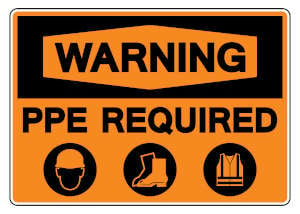Similar to legal malpractice suits, uncovered medi...
 Occupational safety is of the utmost importance, and safety signage requirements are designed to promote safety among employees and visitors alike.
Occupational safety is of the utmost importance, and safety signage requirements are designed to promote safety among employees and visitors alike.
Proper signage can prevent injuries and illnesses in the workplace, cut down on emergencies, and even prevent deaths. Unfortunately, many businesses take a reactive approach to installing safety signs, favoring to implement safety measures after an incident has occurred.
Beyond accident prevention, being proactive about installing safety signs reduces insurance costs, engages workers, and gives everyone a greater sense of social responsibility.
We’ll discuss what you need to know about compliance with safety signage including requirements from OSHA The Occupational Safety and Health Administration (OSHA), requirements, hazard classifications, and placement.
The proper sign in an appropriate location at the right time reduces the chance of serious injury or illness in the workplace. When workers and others clearly understand there is a clear and present danger, they can respond quickly and appropriately.
The types of safety signs a business needs are dependent on the type of industry and business environment. A challenge with safety signage is not all workers have the same capacity for literacy. Furthermore, some workers may not speak English as their first language or may not speak English at all.
For these reasons, it’s important to consider whether safety signs should have pictures only or wording in more than one language. Sign makers are generally quite accommodating when it comes to creating customized signs for commercial workspaces.

The most effective safety signs are those people can easily read from a distance. Some of the more common types of safety signs for workplaces include:
The American Society of Safety Professionals offers three valuable tips for using signage to improve workplace safety including:
Safety rules and regulations stand as guides for how business owners can make improvements to the work environment, along with a good dose of common sense. For more information, the National Safety Council also provides a wealth of information on workplace safety.
The Occupational Safety and Health Administration (OSHA) OSHA sets the standards for safe sign usage. Here is a snippet of some of the more important points:
In addition to the wording, consider the hazard classification and color of your sign to quickly warn employees and visitors of potential danger.
OSHA has set standards for safety signage to alert the general population about the seriousness of a hazard.
Certain signs are posted for general safety or information such as admittance, restroom signs, and open/closed signs. These types of signs are generally green or blue.
OSHA classifies hazards for safety signs in the following three ways:
Red signs should be used in areas where there is the potential for serious injury or death. For example, fire safety signs are always bright red.
Overall, the goal of safety signage is to warn people of potential danger clearly and concisely, and in sufficient time so they can make a safe and wise choice.
OSHA recommends businesses place signs where workers and others can see them from a safe distance. For example, a “wet floor” sign would be yellow to indicate caution, and the best placement for it is around the wet area, so people see the sign before slipping on the wet floor.

Adding to that, businesses should choose a visible placement where the sign itself does not create the potential for a trip and fall hazard.
Safety signage in a commercial business enhances the message your company sends to its employees through its safety policies and procedures.
Be sure to inspect the work environment regularly for hazards and take action to rectify problems. Train all workers in safe equipment operation and other safety protocols. Lastly, consider forming a safety committee that includes safety experts, managers, and employees to help maintain a safe working environment at all times.
 Leap | Carpenter | Kemps Insurance Agency Can Help
Leap | Carpenter | Kemps Insurance Agency Can HelpAccidents can happen even when your company is diligent about providing and maintaining a safe work environment. General liability, occupational accident insurance, and workers’ compensation insurance protect you against liability when someone gets hurt or becomes ill.
Contact one of our expert agents at Leap Carpenter Kemp to learn more about how to protect against the unique risks your company faces at 309-384-0727.
Similar to legal malpractice suits, uncovered medi...
You get all the benefits and advantages of being a...
Natural disasters and crimes can impact a business...
Leap | Carpenter | Kemps Insurance Agency provides Commercial Business Insurance, Employee Benefits, Life and Health Insurance, and Personal Insurance to all of California, including Merced, Atwater, Los Banos, Mariposa, Madera, Fresno, Modesto, Turlock, and Stockton.
CA License Number 0646081 | Licensed to do business in California, Arizona, Hawaii, Idaho, Montana, Nevada, North Carolina, Oklahoma, Oregon, Virginia, West Virginia and Washington.
© Copyright 2023 Leap | Carpenter | Kemps Insurance Agency — Privacy Policy | Terms & Conditions.
Merced Office
3187 Collins Drive
Merced, CA 95348
Phone: (209) 384-0727
Additional Contacts
Toll Free: (800) 221-0864
Fax: (209) 384-0401